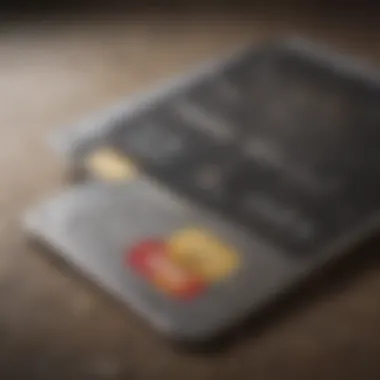Overcoming Credit Card Payment Hurdles for Financial Health


Intro
Managing credit card bill payments can present significant challenges for many individuals. The ability to navigate through the complexities of credit card bills is essential to maintain financial stability. This article delves into the factors surrounding credit card payments, offering insights into both short-term consequences and long-term effects on credit health. It's crucial to understand these implications to make informed financial choices.
By examining the various aspects of credit management, this article aims to equip individuals with knowledge to handle their financial hardships better. Whether contemplating immediate actions or considering longer-term strategies, being proactive can help diminish encumberances stemming from debt.
Understanding Loans
Loans often play a vital role in one's financial life, particularly when managing larger expenses. There are different types of loans available, each tailored to specific needs.
Types of Loans
- Personal Loans: Often unsecured and used for personal expenses.
- Student Loans: Specific for funding education, with terms that can favor young borrowers.
These loans have distinct eligibility criteria, including credit scores and income verification. Before deciding to take a loan, it is vital to weigh the pros and cons that accompany such decisions.
Loan Eligibility Criteria
- Credit Score: Generally, a higher score means better loan terms.
- Income: Lenders will evaluate repayment capability based on income levels and employment stability.
Pros and Cons of Taking Out a Loan
Pros:
- Immediate financial assistance for needed expenses.
- Opportunities to build a positive credit history through responsible payment.
Cons:
- Possibility of long-term debt if not managed appropriately.
- Risk of overdrafts if payment cannot be fulfilled.
Mortgage Essentials
When discussing loans, mortgages are of enormous relevance, especially concerning asset acquisition such as homes. Understanding the various aspects of mortgages is crucial.
Overview of Types of Mortgages
- Fixed-Rate Mortgages: Constant interest rates for stable monthly payments.
- Adjustable-Rate Mortgages: Mortgage rates can fluctuate based on market interest rates.
Each has different application processes, starting typically with getting pre-approved by lenders. It assists potential homeowners clarify their budget.
Mortgage Application Process
- Pre-approval: Initial assessment of creditworthiness.
- Documentation: Required financial records, such as tax returns and pay stubs.
- Approval: Final loan terms contingent on completed assessments.
Home Affordability Calculations
Determining what homes are affordable is often overshadowed by emotional appliance purchases. However, assessing one's budget plays a significant role:
- Calculate Gross Monthly Income.
- Multiply it by 28% – guideline for housing costs.
- Deduct other debts to ascertain affordable mortgage options.
Refinancing Insights
Refinancing a loan is often an option to consider. Understanding its mechanics can help those struggling with current payments.
Reasons to Refinance a Loan
Refinancing can be appropriates for various situations.
- Lower Interest Rates: A chance to reduce monthly payments.
- Debt Consolidation: Combine high-interest debts into a single, lower-rate loan.
Steps Involved in Refinancing
- Review current loan terms.
- Research alternative lenders and rates.
- Execute documents and finalize terms for repayment.
How to Determine if Refinancing is Right for You
Check if potential savings outweigh the closing costs. The payback terms should be manageable and allow for a breath of better cash flow.
Navigating Credit Cards
Credit cards are critical instruments which provide buying power, but they must be used judiciously. Recognizing different types helps reinforce effective usage.
Types of Credit Cards
- Cashback Cards: Returning a percentage of what you spend.
- Rewards Cards: Provide miles or points for traveling and other expenditures.


Credit Card Utilization Tips
- Aim to keep usage under 30% of the credit limit.
- Make payments promptly to avoid interest penalties.
Avoiding Common Credit Card Pitfalls
- Consolidated Payments: Be aware if overspending routinely happens yet repayment capabilities are unaddressed.
- Consider the ongoing impact of small purchases that lead to larger debt.
Protecting with Insurance
Insurance is a financial cushion which helps deal with uncertainties. It's essential to understand various kinds of insurance programs.
Importance of Different Insurance Types
- Health Insurance: Covers medical costs.
- Auto Insurance: Essential coverage for vehicles.
Shopping for Insurance Policies
Before finalizing policies, reviewing and comparing repspective statutes ensure the chosen plan fits your needs.
Understanding Insurance Premiums and Deductibles
Understanding how these work can assist decision-making; numerous factors such as state regulations and health profiles define cost.
Finding such a balance offers better preparednedd, should unfortunate situations arise.
Ensuring easy access to relevant financial information allows individuals to make sound decisions based on factual data rather than emotional triggers.
Understanding Credit Card Debt
Understanding credit card debt is an essential aspect of navigating financial challenges. It offers insight into how debt accumulates and its potential repercussions on one's economic stability. As credit card debt can influence credit scores significantly, comprehending its nuances can aid in making informed decisions and prevent further financial distress.
What is Credit Card Debt?
Credit card debt arises when individuals purchase goods or services using a credit card and fail to pay off the balance in full by the due date. This debt typically comes with interest charges, which accrue every month that the payment is delayed. Petty expenditures can grow into overwhelming amounts due to high interest rates, making it essential to understand the consequences of not managing this type of debt effectively.
When an individual utilizes a credit card, they borrow money from the issuing bank or financial institution. Each transaction increases the total credit card balance, creating a situation where consumers might find it hard to maintain control over their finances. As bills become due, the pressure of full repayment often emphasizes the need to devise a sustainable payment strategy.
Common Causes of Credit Card Debt
Several factors contribute to the accumulation of credit card debt. Some of the most common causes include:
- Overspending: Impulse purchases or excessive use of credit cards for non-essentials can quickly spiral into significant debt.
- Lack of Financial Literacy: Without understanding the terms associated with credit cards, individuals may naively engage in transactions that lead them into financial separates.
- Emergencies and Unforeseen Expenses: Unexpected health issues or car repairs can prompt people to rely on credit cards, leading to unplanned debt incursion.
- Changes in Income: Job loss or decrease in work hours can make it challenging to pay existing credit card bills, which leads to further borrowing.
It is crucial to recognize these elements to devise strategies that alleviate the burden of credit card debt, enabling individuals to regain control over their financial well-being.
The Consequences of Non-Payment
Understanding the consequences of not paying credit card bills is crucial for financial health. This section outlines immediate penalties, impacts on credit score, and potential legal actions that can arise from non-payment. By detailing these aspects, individuals can better grasp the importance of timely payments and the far-reaching implications of neglect.
Immediate Financial Penalties
When a credit card bill is missed, the first response is usually financial penalties. These can manifest in various forms:
- Late Fees: Most credit card companies impose a fee for missed payments. This penalty can quickly add up, compounding the existing debt.
- Increased Interest Rates: If the account is subjected to non-payment, the interest rate may rise. This shift can turn manageable payments into overwhelming balances.
- Minimum Payment Violation: Failing to meet the minimum payment can also lead to serious consequences. Creditors may impose additional fees, causing the debt to balloon.
Individuals often underestimate these penalties, but they can have massive implications over time. Paying on time is not just about avoiding fines, but about maintaining financial stability.
Impact on Credit Score
Perhaps the most significant consequence of non-payment is the effect on one's credit score. A credit score is a numerical representation of a person's creditworthiness:
- Payment History: This significant factor can drop steeply with late payments. Even a single missed payment can lead to a noticeable decline in score.
- Utilization Ratio: Missed payments can affect outstanding balances, leading to a potential increase in credit utilization. This metric also influences credit scores heavily.
- Long-Term Damage: While time can heal scores, severe neglect may lead to long-lasting damage that remains visible on credit reports for seven years.
An excellent credit score often provides better interest rates and terms for loans. Neglect can enhance the cost of borrowing when opportunities arise.
Potential Legal Actions
In cases of continued non-payment, creditors may resort to legal channels to recover the owed money:
- Collections Agencies: Creditors often sell delinquent accounts to collections agencies. This can lead to persistent and rigorous collection efforts.
- Lawsuits: If debts are significant, creditors might initiate lawsuits. Negative judgments can further damage credit scores and open the door to garnishment of wages.
- Bank Levies: Legal circumstances may allow creditors to levy bank accounts. This leaves individuals without accessible funds until the debt is resolved.
The compounding factors can create a cycle of debt that seems impossible to escape. Seeking earlier assistance and understanding payment commitments is vital for avoiding such actions.
The weight of financial consequences can sometimes seem overwhelming, but proactive addressing offers a path towards recovery and control.
Assessing Your Financial Situation


Evaluating your financial health is crutial for managing your credit card bills effectively. When faced with challenges in payment, understanding your overall financial situation helps to create a sustainable roadmap for recovery. It ensures that you know how much you owe, what your income looks like, and which expenses are essential. A thorough assessment of these elements is the first step to regaining control of your finances and avoiding further debt accumulation.
Below are key components to focus on when assessing your financial situation:
- Understanding total debt: Know the full sum of outstanding debts, including hellious credit card balances, to create a strategic repayment approach.
- Income analysis: Evaluate fluctuating revenue sources to precise ly forecast how much you can allot for repayments monthly.
- Expense categorization: A term that means organzing various expenses helps segregate needs from wants, allowing for prioritization in budgeting.
This process carries benefits that foster clear financial management:
- Informed decision-making: By evaluating your finances comprehensively, you can carefully decide how to manage outstanding payments.
- Roadmap creation: Having a precise grasp makes designing either a debt repayment strategy or a budget clear, allowing smoother payout execution.
- Avoidance of future pitfalls: Data gained will reveal spending habits, minimize careless financial behaviors, and therefore prevent future credit mishaps.
Calculating Total Debt
Calculating your total debt means gathering all relevant information about your outstanding obligations. This figure should include all credit cards as well as any other consu mer debt, such as personal loans. Tracking down this information offers a holistic view of financial commitment—critical in possible someday recovery outcomes.
Elements of calulation you should consider:
- Credit card detailed statements: Collect all active accounts statements to comprehensivly sum debts.
- Loan statements: Whereas aggregation is importnat for insight, consider car loans or student loans too.
- Any collateral commitment like mortgages: As these can affect your overall debt profile, ensure to take acount of them as well.
Totaled data creates better layout planning directly offering ! appropriate pay segments for monthly payouts. Understand completly authorities settbled dues eventually guards from penalty-mismanagement.
Creating a Budget
A budget serves as a directive framework for one’s financial future. It aligns income against necessary payments. A clear idea of expenditure levels stopped everyone spiralling down too unfair debt. Build yours in consecutive two phases:
- Establishing input streams: Total your income sources after taxes.
- This may mix from dependent earnings, tributary assets, or side hustles.
- Expense measurements: Focus onto attendees only expenses monitor through gathers:
- Fixed costs (like housing and tangible utilities)
- Variable spending (groceries or entertainment)
This worksheet then becomes essential for curaying subsequent installment planning choices down either jew-grizzly key pieces finding pockets of reshuffling leanness should unattended trends intersporse.
Identifying Necessary Expenses
After crafting an accurate budget, discerning necessary expenses allows prioritization in confrontation toward beginning repayment orders. Distinguishing essential bills can highlight priorit destinations to loan debts versus items that can decline or shift. Craft out your list like so:
- Must-haves in lifecycle: These mainly consist of housing, utilities revenue, tor tough issues contribution such as sustenance quality.
- Fixed payment items: Plan foring auto-pays executing aid costs aimed maximizing consumption-wise rightly throughout joined phases too.
- Lifestyle adjustments: Examine softer infrequent items that could forsake pent-up redistribution without existential alternations. Think alternatives while adjusting reminder products substituting kudos ingrained on downgrades watched. These processes lever old joints vigilant enable conservation securing joints cursorially at unsoiled balanced guide-raised outlook only.
By recognizing these expenses could truly forecast systems sustained toward clearing debts steadily relentlessly integrated upaccumulately faithfully. Ensure an open perspective leads liberatory pathways beyond colorful debts held unlockedy.
Exploring Alternative Solutions
In the context of managing credit card debt, exploring alternative solutions becomes a vital aspect of financial health. Individuals often find themselves overwhelmed by growing balances and minimum payment demands. Understanding and pursuing different avenues can prevent financial situations from worsening. Alternative solutions equip borrowers with practical methods to regain control over their financial obligations.
Overall, alternatives provide relief while also enhancing understanding about one's financial standing. They empower individuals with better options to move forward instead of feeling stuck in a cycle of debt. Approaching the issue head-on can mitigate stress and enable a more structured repayment plan.
Negotiating with Creditors
Negotiating with creditors is a powerful yet often overlooked strategy for debt management. Many lenders understand that financial hardship can happen. By reaching out to a creditor, individuals may find they can negotiate more favorable terms, such as lower interest rates or extended payment periods.
Here are important points to consider:
- Be Honest: Transparency about your situation can lead to favorable outcomes.
- Prepare Your Case: Gather necessary documentation that may help your case.
- Stay Calm: Being composed forms part of productive communication.
Taking this step may lead not just to immediate relief, but can also strengthen the relationship with a lender. If they see efforts to work things out, they might be more empathetic in the future.
Debt Consolidation Options
Debt consolidation is another effective tool to manage credit card payments. This method combines multiple debts into a single loan, typically with lower interest rates. Consolidation makes it more manageable to track payments and reduce total interest expenses over time.
When considering debt consolidation, here are key factors:
- Type of Loan: Options include personal loans, home equity loans, or balance transfer credit cards. Each has different terms and associated risks.
- Credit Score Impact: Understanding how consolidation affects your credit score is crucial before proceeding.
- Long-Term Commitment: Have a clear repayment strategy following consolidation.
Evaluating different avenues of consolidation ensures one finds the right fit for their specific needs and budget.
Seeking Professional Advice
Turning to a trained professional is another pragmatic approach to navigating credit card payment challenges. Certified financial planners or credit counselors have expertise in the realm of debt management and can offer tailored advice suited to individual financial circumstances.
Key considerations include:
- Accessibility: Assess which professionals are readily available and their warning signs of caution.
- Credibility: Ensure the advisor has relevant certifications and a reputable track record.
- Personalization: Good advisors create plans tailored to unique situations and perspectives rather than using generic templates.
Overall, professional advice offers individuals valuable insight into managing debt strategically, outlining potential options specific to their concerns.


Implementing a Repayment Strategy
Implementing a repayment strategy serves as a vital stepping stone in overcoming credit card challenges. This strategy allows individuals to construct a structured approach towards reducing outstanding balances, ultimately leading to improved financial health. Notably, a well-defined repayment plan can help manage high-interest debts more effectively and avert long-term financial distress. Establishing this strategy requires meticulous planning and consideration of one's current financial condition.
Prioritizing High-Interest Debt
One of the primary aspects of an effective repayment strategy is prioritizing high-interest debt. Credit card interest rates can vary significantly, with some being substantially higher than others. Targeting these high-interest accounts first can lead to overall interest savings. Focus on paying more than the minimum payment on these cards. It’s also advisable to switch to the avalanche method, where you allocate any extra funds to the debt with highest interest, while making minimals on others. This approach reduces the total cost of borrowing over time, thus offering a clear financial advantage.
Benefits of Prioritization:
- Reduces total interest paid.
- Moves towards balance reduction more efficiently.
- Creates momentum as debts decrease.
Setting Realistic Payment Goals
Setting realistic payment goals is essential in any repayment strategy. It is easy to become overwhelmed when looking at the total debt. Therefore, carving out specific, reachable targets is crucial. Outline how much you can afford to pay each month based on your budget. Consider all necessary expenses first. Establish both short-term goals for quick wins and long-term goals for the overall reduction. Consistent progress facilitates confidence, keeping motivation intact throughout the repayment journey.
Practical Considerations for Goal Setting:
- Assess your monthly income and expenses.
- Determine feasible amounts beyond minimum payments.
- Adjust based on any changes in income or expense.
Monitoring Progress
To maintain focus and ensure success in your repayment strategy, regular monitoring is vital. Create a method or tool—be it a spreadsheet or an app—to track the progress of your payments. Mark milestones showing how much has been paid off. Visual representations can make this process clearer and more motivating. Consistent monitoring of progress instills accountability and encourages sustained effort in repayment.
“Success in credit card debt repayment is not just about the numbers, but the adjustments you make along the way.”
Key Aspects to Track:
- Amount paid towards debt.
- Remaining balances on each card.
- Changes in credit scores over time.
By implementing these component strategies, a solid foundation emerges for tackling credit card debts effectively. Each step taken brings you closer to financial freedom, painting a clearer picture of your monetary future.
Preventing Future Financial Problems
Preventing financial problems is a key focus in the realm of credit card usage and payments. Addressing potential future obstacles is just as crucial as dealing with immediate debt. Developing solid strategies before trouble arises can mitigate risks, ensure healthier financial habits, and enhance overall financial stability.
Establishing a Savings Plan
Creating a savings plan requires a careful assessment of income and funds. Allocate a portion of your monthly income specifically for savings. It can serve as an emergency fund for your handling unexpected expenses or gaps in income. Many experts suggest aiming for three to six months’ worth of living expenses. Building this cushion reduces reliance on credit in urgent situations.
Being consistent is essential. Setting up automatic transfers to a savings account can streamline this practice. By making saving a non-negotiable part of your budget, it becomes easier to cultivate the habit, without relying solely on willpower. Use high-yield savings accounts or other secure investment vehicles to grow your savings efficiently.
Understanding Responsible Credit Use
Responsible credit utilization means knowing how and when to use your credit cards. This involves spending within your means and avoiding excessive debt. Users should only charge what they can repay. Generally, keeps the assertion under 30% of available credit is advisable, as it favors credit scores.
Further, it is crucial to read and understand terms of credit card policies. Pay attention to the fine print, concerning interest rates, fees, and payment due dates. Evaluating these aspects allows you to make more informed decisions and anticipate final costs accurateley.
Fostering positive habits such as timely bill payments refs in improved credit history. A careful strategy here manifests solid financial health down the road, making future borrowing less restrictive and less taxing.
Monitoring Credit Reports
Regularly monitoring credit reports gives insightful information about your financial footing. Credit bureaus like Experian and TransUnion provide access to reports. Check these reports at least once a year and address inaccuracies promptly. Known errors on your credit report could lead to regulations in borrowing eligibility and interest rates risk averse, this might come at a higher cost later.
Keeping an eye on your credit report also enables tracking changes in score. Trends or shifts depict spending habits and payment punctuality. Take proactive steps if necessary; learning to swiftly identify issues prevents larger complications later on.
Regular review of your financial standing creates space for correction.
Understanding these critical aspects enables a robust connection to navigate the landscape of real world financial decisions. By putting them into daily practice, the roadmap to maintaining positive credit behavior begins with a sequence of small, disciplined steps that build up into a reliable financial foundation.
End
In this final part, we emphasize the value of understanding how to navigate the challenges of paying credit card bills. Credit card management is not just about making the payments; it requires a comprehensive approach to one's financial health. The broader outlook includes financial responsibility and informed decision-making. These factors are vital for improving one's credit score and maintaining overall financial stability.
Summarizing Key Takeaways
It is crucial to recognize the key points discussed in this article. Understanding credit card debt is fundamental. Various elements contribute to the debt situation, such as overspending, emergencies, or even lifestyle choices. Strikingly, failing to resolve this debt creates severe consequences, ranging from immediate penalties to long-term damage to credit ratings.
Some essential takeaways are:
- Immediate attention is essential; late payments lead to higher interest rates and financial penalties.
- Evaluation of one's entire financial scenario is necessary to devise an effective repayment strategy.
- Individuals should explore alternative plans and solutions, such as negotiating with creditors or seeking proessional help.
Monitoring progress and establishing healthy financial habits will help in preventing future credit card issues. Each part of the journey steps towards reclaiming control over one's financial life.
Encouragement for Financial Literacy
The journey towards financial health requires knowledge and diligence. Financial literacy is not just a term; it encompasses the skills to make informed decisions regarding money management. Regularly educating oneself brings benefits that are crucial for long-term financial success.
Taking steps such as reading finance-related content, attending webinars, or participating in forums can empower individuals.
'Education is the most powerful weapon which you can use to change the world' - Nelson Mandela
Moreover, frequent engagement with tools like credit reports enables users to stay informed. Individuals ought to tackle challenges with clarity and pragmatism. In doing that, a more secure economic future will be achieved, placing people in control of their financial destinies.







